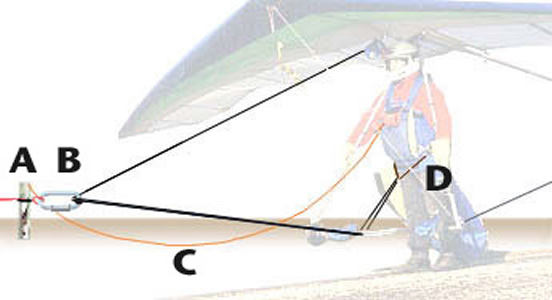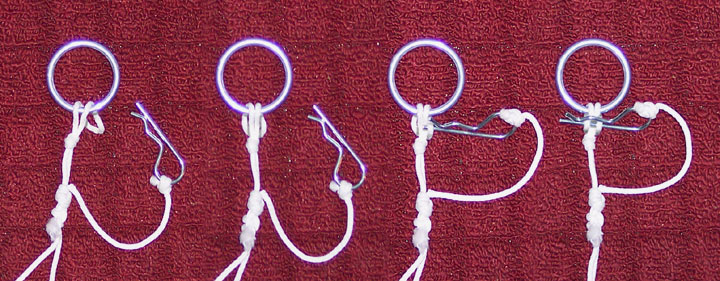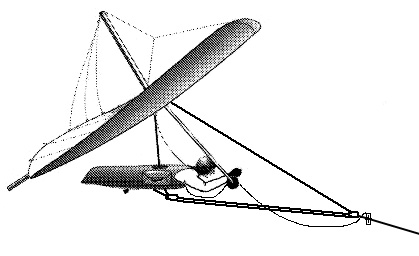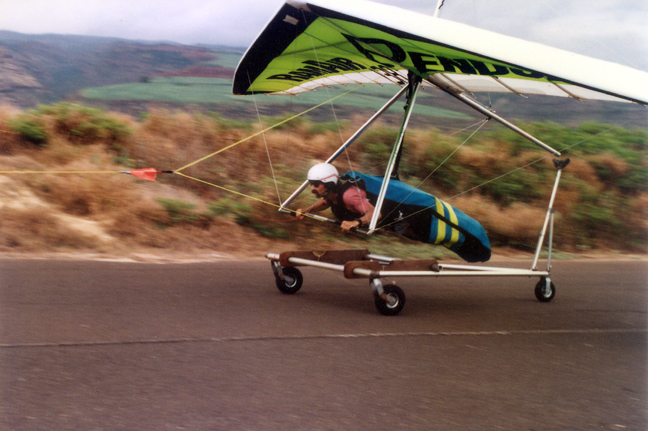

![]()
The Reel Pilots use the Hewett Center-of-Mass bridle for foot launched static line towing of our hang gliders. It's basically a 2:1 pulley that's arranged thusly:
The main bridle must be much stronger than the towline to prevent a bungee-like snap-back to your face. Bridle measures 20-24 feet (7+ meters). Material should be a no-stretch line like perlon, spectra, or a particular 900-pound test like I found at a skydiving supply house. (You can order a bridle kit for static or aero towing here.)
Affix the bridle to the keel from 1" to 14" forward of the hang point (the newer you are, the farther forward it should be attached for the first few dozen or so tows). Important: Attach so that it will not slide forward on the keel tube, probably with a restraining line to the kingpost or top of downtubes.
Beginning at the keel, the bridle line passes through a ring at the "apex" or towline attach point, through a 1/4" rapid link ("B" in photo below) and routes back to the pilot's waist UNDER the control bar.
At the pilot's waist (D) there's an attachment like a sailboat shackle. There are 2 purposes for the shackle: as a second "pulley" to permit smooth sliding of the bridle while being towed and to disconnect the bridle from the pilot after the tow. Bridle routes through this shackle and back UNDER the bar to the apex where it's firmly tied to the steel ring/link. Bowline is a good knot for this setup.

Black = Bridle: non-stretch line for main and waist bridle
A (Red) = weaklink through Linknife
B (LtBlue) = 1/4" (6mm) rapid link
C (Orange) = Release line with slack
D = Shackle on waist line to allow "pulley" action and release after tow
![]()
At the pilot's center-of-mass - usually the waist - a short bridle retains the shackle and is set to limit side to side movement. Tie a knot, weave a loop, whatever... keep it solid and keep it short.
This bridle must be short enough to keep the shackle from contacting the control bar. Appropriate size would allow one fist-width between bridle and harness. It can be attached to waist loops on most modern harnesses or can be a sewn loop on the harness skirt; grommets can be placed in the skirt for the bridle to wrap around the leg loops... it's your choice depending on what type of harness you own.
Wes Schield developed this waist bridle release (below) using a welded ring and bridle material. This design permits one-handed dropping of the bridle after releasing from the towline. The photos show a prototype for concept, not material type or size, though in practice it works great.


A sailing snap shackle is also a good choice, like this one from West Marine (their model #121046)
![]()
Here's how the static towing bridle looks in flight:

This illustration above shows the pilot/glider/bridle orientation at maybe 200-500 feet off the ground. Illustration based on one from the Canadian Towing Manual.

At the top of tow (no matter how much towline used) the upper bridle line will contact the base tube. It's not necessary to push hard against the base tube as that will likely cause the glider to stall. A little pushing may be OK to maximize the climb but the conditions of the day will have a lot to do with how much "push out" can be used. Upon release, the release line is first wrapped up and stowed, then the bridle is disconnected from the waist, wrapped up and stowed. The whole procedure takes about 30 seconds. But always make sure to fly the glider and stay in control.
It is important to have the bridle stowed prior to landing so it doesn't catch on anything on the ground.
![]()
Don't try this without expert
supervision and training.
You could seriously hurt yourself
by not knowing what you are
about to experience.
Aside from recent flying experience and a good working knowledge of hang glider flight, foot launched towing requires the pilot to hold AoA (Angle of Attack) against the upward pull of the low part of the bridle when tension is applied. As tension is applied, the pilot must RESIST the towline force so that tension builds in the line. As forward movement is attained and the wing produces lift, the glider will rise and find its trim point... pull in a bit to get better flying speed until well away from the ground, then let the bar slowly to trim and climb away.
If any part of the bridle touches
the front flying wires,
RELEASE!
Corrections are made by "bumping the bar" to maintain a straight-ahead heading – yaw and roll corrections are NOT done by "turning" the glider. Fully shifting weight will result in increasing PIO.
After releasing, roll up the bridle and stow it in your harness or side wires. DO NOT let it drag behind you on landing.
A little aside to comparing static line to payout: One of our pilots moved to Missouri several years ago after becoming an accomplished static tow pilot here. He of course brought his static system with him. Was told by the locals that they "used to do static but have graduated to payout". So he set up his static line and beat their pants off on every launch... they could never get as high on payout as he did on static line.
![]()
Do not mount anything on the base tube. It must be kept free of things that would snag the bridle in any way. A little snag, combined with a little roll while on tow, can make for setting up a lockout.
A straight base tube is better than a speed bar for static towing. The bridle has less of a chance of locking in on one side of a speed bar. (Just a suggestion)
Lower line and harness bridle
I don't know what kind of harness you fly in, but most have hip loops. Using 1/4" or so rapid links and material similar to the main bridle, make a short waist bridle that attaches to both sides of the harness. Sew or tie a loop into the middle of the line with a shackle or beener that can't move side-to-side. The length of the bridle should be set so there's maybe a "fist" of room between it and the harness. One reason for the "fist" space is that at launch you don't want the shackle/ beener/ whatever catching on the base tube. KISS!
You should be able to easily attach all bridles while on the ground during setup, and very easily remove the main bridle after release. No fabric-on-fabric... but you know that.
On my old AirFlare pod and on an Airstream dorsal fin pod, I set grommets in the "skirt" so the hip-bridle could wrap around the leg loops. I can't do this with my Airtime LaZer harness now but must use the sewn-in hip loops.
Some pilots pull only from the chest. In this arrangement there is no tow force applied to the glider. I have only seen the over/under "Euro release" used a couple of times and have not yet flown with this arrangement. It's reported to have good success, but within our club the one pilot who did attempt it experienced his first lockout.

A chest-only bridle being used with a "Scooter Tow", a variation on the stationary winch. (Can't say too much about the pilot's style) Photo provided by Dave Broyles, Allen TX
I do not recommend using one on the pilot for static line towing. The arrangement for such a backup would add far too much complexity to the system. Your best bet is to become intimately familiar with your hook knife and make sure it's where you can quickly reach it. A backup at the car is a wonderful idea to dump all towline tension immediately, however this can present new problems like the pilot could be left dragging several thousand feet of towline that can snag on a ground obstacle.
In my 1000+ tows, I've had to use my hook knife three times... the first was on a pulley tow when an old 2-string release didn't work. Sure did need that hook knife... and RIGHT NOW! Though it worked fine and I lost the bridle and release, it gave me the inspiration to come up with the Linknife.
Backup at the keel
You might be tempted to experiment with a secondary release at the keel. When we first were towing in '82 to about '86, there were a few pilots who had their main release there... we called it a threaded bridle. Couple of pilots got hurt when the bridle line came whipping back at them. We've since banned 'em.
![]()
The Linknife is a release that cuts the weaklink. It's small and light and can be used in a number of ways with a tow bridle system for static, payout and aerotowing.
I use one Linknife only as my main release for both static line and aerotowing. For aerotow, I place the release at the same position as with the static Hewett system, at the bridle apex where the bridle and towline meet. Not only does this keep things simple (same release for all systems) but it eliminates any unthreading hang-up potential and saves weight and complexity.
My release line is attached to the harness shoulder. I use a small dog leash reel at the harness, so after releasing it's a simple matter to pull the tab and - zip- the release line is automatically rewound. Gotta make sure to lock the reel before launching so at the time of release, especially in an emergency, you will not hit the line and just pay out more line (can you guess how I found this out? Yup, the hard way).

Launching from a dolly using a Hewett 2:1 bridle.
![]()
NEXT PAGES:
General overview
Parts of the system
Bridle info
Driver info
Towing criteria
Linknife Static Tow
DISCLAIMER: As with all aviation endeavors, your choice and use of equipment is totally up to you. It is assumed you are an experienced HG or PG tow pilot who is intimately familiar with the style of towing you will be doing. As such, YOU ASSUME ALL RISK AND LIABILITY in the use of the Linknife, as well as all other parts, functions and personnel involved in the towing and flight operations. If you do not have experience in towing, please contact an instructor for expert training. Trying to learn on your own can, and probably will, result in your injury and even death. Many pilots have paid the ultimate price so we may now tow as safely as never before possible. Please learn from their lessons.
Linknife Home | Static Line | Payout/Platform | Aerotow | Testimonials
Reel Pilots Home |
Hewett's Towing Criteria |
Driver SOP
Static Line Basics |
Static Towing Parts |
Hewett Bridle Basics
Parachutes |
Lockouts |
Payout Primer |
Flying Sites
Links clubs/info |
Links2 states/countries
Airshow |
Site Opening Primer
Birren Design Company | Site Map
©2000-2023 Peter Birren email
Powered by w3.css